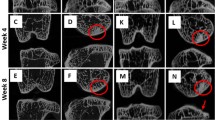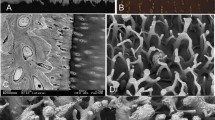Abstract
This study aims to investigate how biochemical composition in subchondral bone (SB) relates to the sulfated glycosaminoglycan (sGAG) content of articular cartilage (AC) in the knee joint of guinea pigs from the early to moderate osteoarthritis (OA). Male Dunkin Hartley strain guinea pigs were grouped according to age (1, 3, 6, and 9 months, with 10 guinea pigs in each group). The biochemical properties of the AC and SB in the tibial plateau of the guinea pigs were determined through histology and Raman spectroscopy, respectively. Furthermore, the microstructures of the SB were investigated using micro-computed tomography (micro-CT) and histology. Increased thickness and bone mineral density (BMD) and decreased porosity were observed in the subchondral plate (SP) with the progression of spontaneous OA, accompanied by a decreasing trend in sGAG integrated optical density (IOD) of AC. Compared with the changes in the microstructure of subchondral bone, the content of sGAG was more correlated to the changes in the mineral/matrix ratio of subchondral bone. The mineralization of the matrix was significantly correlated to the content of sGAG compared with crystallinity/maturity and Type B carbonate substitution. PO43− ν1/Amide III was more correlated to the content of sGAG than PO43− ν1/Amide I, PO43− ν1/CH2 wag during the progression of spontaneous osteoarthritis. This study demonstrated that the mineralization of subchondral bone plays a crucial role in the pathogenesis of OA. Future studies may access to the mineralization of subchondral bone in addition to its microstructure in the study for pathogenesis and early diagnosis of osteoarthritis.




Similar content being viewed by others
Data Availability
The data that support the findings of this study are available from the corresponding author upon reasonable request.
References
Felson DT, Lawrence RC, Dieppe PA, Hirsch R, Helmick CG, Jordan JM, Kington RS, Lane NE, Nevitt MC, Zhang Y (2000) Osteoarthritis: new insights. Part 1: the disease and its risk factors. Ann Internal Med 133(8):635–646
Lawrence RC, Felson DT, Helmick CG, Arnold LM, Choi H, Deyo RA, Gabriel S, Hirsch R, Hochberg MC, Hunder GG (2008) Estimates of the prevalence of arthritis and other rheumatic conditions in the United States: Part II. Arthritis Rheum 58(1):26–35
Findlay DM, Kuliwaba JS (2016) Bone–cartilage crosstalk: a conversation for understanding osteoarthritis. Bone Res 4:16028
Hamann N, Zaucke F, Dayakli M, Brüggemann GP, Niehoff A (2013) Growth-related structural, biochemical, and mechanical properties of the functional bone–cartilage unit. J Anat 222(2):248–259
Loeser RF, Goldring SR, Scanzello CR, Goldring MB (2012) Osteoarthritis: a disease of the joint as an organ. Arthritis Rheum 64(6):1697–1707
Lories RJ, Luyten FP (2011) The bone–cartilage unit in osteoarthritis. Nat Rev Rheumatol 7(1):43
Bailey AJ, Mansell JP, Sims TJ, Banse X (2004) Biochemical and mechanical properties of subchondral bone in osteoarthritis. Biorheology 41(3–4):349–358
Stolz M, Gottardi R, Raiteri R, Miot S, Martin I, Imer R, Staufer U, Raducanu A, Duggelin M, Baschong W, Daniels AU, Friederich NF, Aszodi A, Aebi U (2009) Early detection of aging cartilage and osteoarthritis in mice and patient samples using atomic force microscopy. Nat Nanotechnol 4(3):186–192. https://doi.org/10.1038/nnano.2008.410
Yu DG, Nie SB, Liu FX, Wu CL, Tian B, Wang WG, Wang XQ, Zhu ZA, Mao YQ (2015) Dynamic alterations in microarchitecture, mineralization and mechanical property of subchondral bone in rat medial meniscal tear model of osteoarthritis. Chin Med J 128(21):2879–2886. https://doi.org/10.4103/0366-6999.168045
Zuo Q, Lu S, Du Z, Friis T, Yao J, Crawford R, Prasadam I, Xiao Y (2016) Characterization of nano-structural and nano-mechanical properties of osteoarthritic subchondral bone. BMC Musculoskel Dis 17(1):367
Brama P, TeKoppele J, Bank R, Barneveld A, Van Weeren P (2002) Biochemical development of subchondral bone from birth until age eleven months and the influence of physical activity. Equine Vet J 34(2):143–149
Mansell JP, Bailey AJ (1998) Abnormal cancellous bone collagen metabolism in osteoarthritis. J Clin Investig 101(8):1596–1603
Harst MR, DeGroot J, Kiers GH, Brama PA, Lest CH, Weeren PR (2005) Biochemical analysis of the articular cartilage and subchondral and trabecular bone of the metacarpophalangeal joint of horses with early osteoarthritis. Am J Vet Res 66(7):1238–1246
Esmonde-White KA (2009) Raman Spectroscopy Detection of Molecular Changes Associated with Osteoarthritis. Doctoral dissertation, University of Michigan, Deepblue
Pustjens M, Mastbergen S, Noort-Van der Laan W, Van Heerwaarden R, Lafeber F (2014) The biochemical interaction between subchondral bone and cartilage in osteoarthritis. Osteoarthr Cartil 22:S352–S353
Anderson-MacKenzie JM, Quasnichka HL, Starr RL, Lewis EJ, Billingham ME, Bailey AJ (2005) Fundamental subchondral bone changes in spontaneous knee osteoarthritis. Int J Biochem Cell Biol 37(1):224–236
Yamada K, Healey R, Amiel D, Lotz M, Coutts R (2002) Subchondral bone of the human knee joint in aging and osteoarthritis. Osteoarthr Cartil 10(5):360–369
Burr DB (1998) The importance of subchondral bone in osteoarthrosis. Curr Opin Rheumatol 10(3):256–262
Carlson CS, Loeser RF, Jayo MJ, Weaver DS, Adams MR, Jerome CP (1994) Osteoarthritis in cynomolgus macaques: a primate model of naturally occurring disease. J Orthopaed Res 12(3):331–339
Radin EL, Rose RM (1986) Role of subchondral bone in the initiation and progression of cartilage damage. Clin Orthop Relat R 213:34–40
Pearle AD, Warren RF, Rodeo SA (2005) Basic science of articular cartilage and osteoarthritis. Clin Sports Med 24(1):1–12
Miosge N, Hartmann M, Maelicke C, Herken R (2004) Expression of collagen type I and type II in consecutive stages of human osteoarthritis. Histochem Cell Biol 122(3):229–236
Maroudas A, Bayliss M, Venn M (1980) Further studies on the composition of human femoral head cartilage. Ann Rheum Dis 39(5):514–523
van Tiel J, Siebelt M, Reijman M, Bos P, Waarsing J, Zuurmond A-M, Nasserinejad K, van Osch G, Verhaar J, Krestin G (2016) Quantitative in vivo CT arthrography of the human osteoarthritic knee to estimate cartilage sulphated glycosaminoglycan content: correlation with ex-vivo reference standards. Osteoarthr Cartil 24(6):1012–1020
Watrin A, Ruaud JPB, Olivier PT, Guingamp NC, Gonord PD, Netter PA, Blum AG, Guillot GM, Gillet PM, Loeuille DH (2001) T2 mapping of rat patellar cartilage. Radiology 219(2):395–402
Donohue JM, Buss D, Oegema TR Jr, Thompson RC Jr (1983) The effects of indirect blunt trauma on adult canine articular cartilage. JBJS 65(7):948–957
van der Harst MR, Brama PA, van de Lest CH, Kiers GH, DeGroot J, van Weeren PR (2004) An integral biochemical analysis of the main constituents of articular cartilage, subchondral and trabecular bone. Osteoarthr Cartil 12(9):752–761
Cope P, Ourradi K, Li Y, Sharif M (2019) Models of osteoarthritis: the good, the bad and the promising. Osteoarthr Cartil 27(2):230–239
Huebner J, Hanes M, Beekman B, TeKoppele J, Kraus V (2002) A comparative analysis of bone and cartilage metabolism in two strains of guinea-pig with varying degrees of naturally occurring osteoarthritis. Osteoarthr Cartil 10(10):758–767
Zamli Z, Robson Brown K, Tarlton JF, Adams MA, Torlot GE, Cartwright C, Cook WA, Vassilevskaja K, Sharif M (2014) Subchondral bone plate thickening precedes chondrocyte apoptosis and cartilage degradation in spontaneous animal models of osteoarthritis. Biomed Res Int. https://doi.org/10.1155/2014/606870
Jimenez PA, Glasson SS, Trubetskoy OV, Haimes HB (1997) Spontaneous osteoarthritis in Dunkin Hartley guinea pigs: histologic, radiologic, and biochemical changes. Comparat Med 47(6):598–601
Lin BY (1997) Characterization of the properties of cartilage in the Hartley guinea pig spontaneous osteoarthritis model. Doctoral, Massachusetts Institute of Technology, DSpace@MIT
Kraus VB, Huebner JL, DeGroot J, Bendele A (2010) The OARSI histopathology initiative–recommendations for histological assessments of osteoarthritis in the guinea pig. Osteoarthritis Cartil 18:S35–S52
Otsuki S, Brinson DC, Creighton L, Kinoshita M, Sah RL, D’Lima D, Lotz M (2008) The effect of glycosaminoglycan loss on chondrocyte viability: a study on porcine cartilage explants. Arthritis Rheum 58(4):1076–1085
Martin I, Obradovic B, Freed LE, Vunjak-Novakovic G (1999) Method for quantitative analysis of glycosaminoglycan distribution in cultured natural and engineered cartilage. Ann Biomed Eng 27(5):656–662
James TM, Schlösser M, Lewis RJ, Fischer S, Bornschein B, Telle HH (2013) Automated quantitative spectroscopic analysis combining background subtraction, cosmic ray removal, and peak fitting. Appl Spectrosc 67(8):949–959
Gamsjaeger S, Masic A, Roschger P, Kazanci M, Dunlop J, Klaushofer K, Paschalis E, Fratzl P (2010) Cortical bone composition and orientation as a function of animal and tissue age in mice by Raman spectroscopy. Bone 47(2):392–399
Morris MD, Mandair GS (2011) Raman assessment of bone quality. Clin Orthop Relat R 469(8):2160–2169
Meziane EK, Boot-Handford R, Wallis G (2006) Dunkin Hartley guinea pig as a model for osteoarthritis. Int J Exp Pathol 87(1):A34–A35
Yan J-Y, Tian F-M, Wang W-Y, Cheng Y, Xu H-F, Song H-P, Zhang Y-Z, Zhang L (2014) Age dependent changes in cartilage matrix, subchondral bone mass, and estradiol levels in blood serum, in naturally occurring osteoarthritis in Guinea Pigs. Int J Mol Sci 15(8):13578–13595. https://doi.org/10.3390/ijms150813578
Dehring KA, Crane NJ, Smukler AR, McHugh JB, Roessler BJ, Morris MD (2006) Identifying chemical changes in subchondral bone taken from murine knee joints using Raman spectroscopy. Appl Spectrosc 60(10):1134–1141
Buchwald T, Niciejewski K, Kozielski M, Szybowicz M, Siatkowski M, Krauss H (2012) Identifying compositional and structural changes in spongy and subchondral bone from the hip joints of patients with osteoarthritis using Raman spectroscopy. J Biomed Opt 17(1):017007
Farlay D, Panczer G, Rey C, Delmas PD, Boivin G (2010) Mineral maturity and crystallinity index are distinct characteristics of bone mineral. J Bone Miner Metab 28(4):433–445
Zhai M, Lu Y, Fu J, Zhu Y, Zhao Y, Shang L, Yin JJ (2019) Fourier transform infrared spectroscopy research on subchondral bone in osteoarthritis. Spectrochim Acta Part A Mol Biomol Spectrosc 218:243–247
Chen Y, Hu Y, Yu YE, Zhang X, Watts T, Zhou B, Wang J, Wang T, Zhao W, Chiu KY (2018) Subchondral trabecular rod loss and plate thickening in the development of osteoarthritis. J Bone Miner Res 33(2):316–327
Kuroki K, Cook C, Cook J (2011) Subchondral bone changes in three different canine models of osteoarthritis. Osteoarthr Cartil 19(9):1142–1149
Mohan G, Perilli E, Kuliwaba JS, Humphries JM, Parkinson IH, Fazzalari NL (2011) Application of in vivo micro-computed tomography in the temporal characterisation of subchondral bone architecture in a rat model of low-dose monosodium iodoacetate-induced osteoarthritis. Arthritis Res Ther 13(6):R210
Wang T, Wen C-Y, Yan C-H, Lu W-W, Chiu K-Y (2013) Spatial and temporal changes of subchondral bone proceed to microscopic articular cartilage degeneration in guinea pigs with spontaneous osteoarthritis. Osteoarthr Cartil 21(4):574–581
Zamli Z, Robson Brown K, Sharif M (2016) Subchondral bone plate changes more rapidly than trabecular bone in osteoarthritis. Int J Mol Sci 17(9):1496
Anumula S, Wehrli SL, Magland J, Wright AC, Wehrli FW (2010) Ultra-short echo-time MRI detects changes in bone mineralization and water content in OVX rat bone in response to alendronate treatment. Bone 46(5):1391–1399
Roschger P, Paschalis E, Fratzl P, Klaushofer K (2008) Bone mineralization density distribution in health and disease. Bone 42(3):456–466
Funding
This work was supported by the National Natural Science Foundation of China (Nos. 11872095 and 31570945) and National Key Research and Development Program (No. 2016YFB1101101).
Author information
Authors and Affiliations
Contributions
PR had full access to all of the data in the study and takes responsibility for the integrity of the data and the accuracy of the data analysis. Conception and design of the study: PR, HN, HG, YF; Acquisition of data: PR, HC, SJ; Analysis and interpretation of data: PR, HN, HG, YF; Drafting the manuscript: PR, HN, HC, SJ; Final approval: all authors.
Corresponding author
Ethics declarations
Conflict of interest
The authors declare that they have no competing interests.
Ethical Approval
This study was performed in strict accordance with the recommendations of the Laboratory Animal Standardization Committee and was approved by the Science and Ethics Committee of the School of Biological Science and Medical Engineering in Beihang University, China (Approval ID: BM201900064).
Additional information
Publisher's Note
Springer Nature remains neutral with regard to jurisdictional claims in published maps and institutional affiliations.
Rights and permissions
About this article
Cite this article
Ren, P., Niu, H., Cen, H. et al. Biochemical and Morphological Abnormalities of Subchondral Bone and Their Association with Cartilage Degeneration in Spontaneous Osteoarthritis. Calcif Tissue Int 109, 179–189 (2021). https://doi.org/10.1007/s00223-021-00834-3
Received:
Accepted:
Published:
Issue Date:
DOI: https://doi.org/10.1007/s00223-021-00834-3




